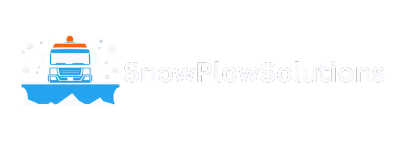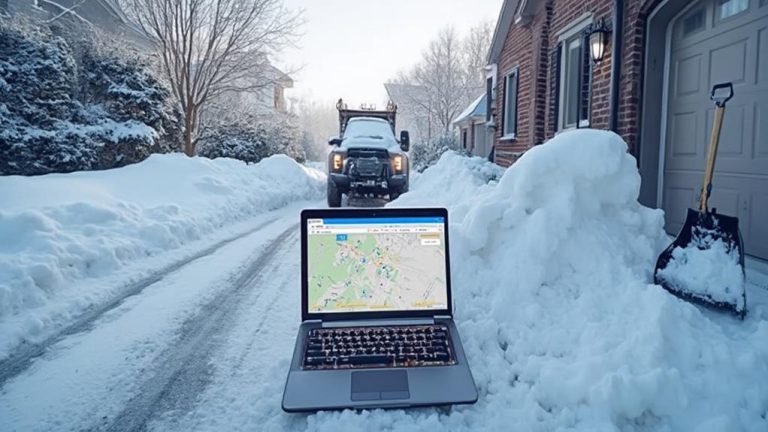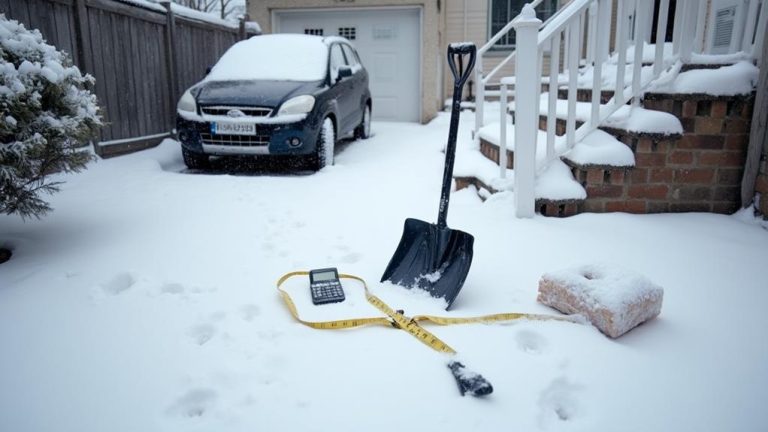Snow plowing route optimization enhances winter road maintenance efficiency through advanced technology and strategic planning. You'll benefit from GIS-based mapping, real-time weather monitoring, and data-driven resource allocation. This approach prioritizes main arteries, emergency routes, and critical infrastructure, ensuring faster response times and improved public safety. By optimizing routes, you'll minimize fuel consumption, reduce equipment wear, and conserve de-icing materials. The result is a cost-effective, sustainable snow management strategy that maximizes area coverage while minimizing disruptions to traffic flow and daily activities. Implementing these techniques can substantially improve your winter maintenance operations, leading to safer roads and more satisfied residents. Further exploration of this topic will reveal additional advantages and implementation strategies.
Snow Plowing Highlights
- Analyze road networks to prioritize main arteries and emergency routes for efficient plowing.
- Utilize GIS and specialized software to create optimized digital maps and routes.
- Implement real-time weather monitoring to make informed decisions about plowing deployment.
- Allocate resources strategically, using a tiered system to prioritize critical areas.
- Leverage data analytics to reduce fuel consumption, labor hours, and equipment wear.
Efficient Winter Road Maintenance Strategy
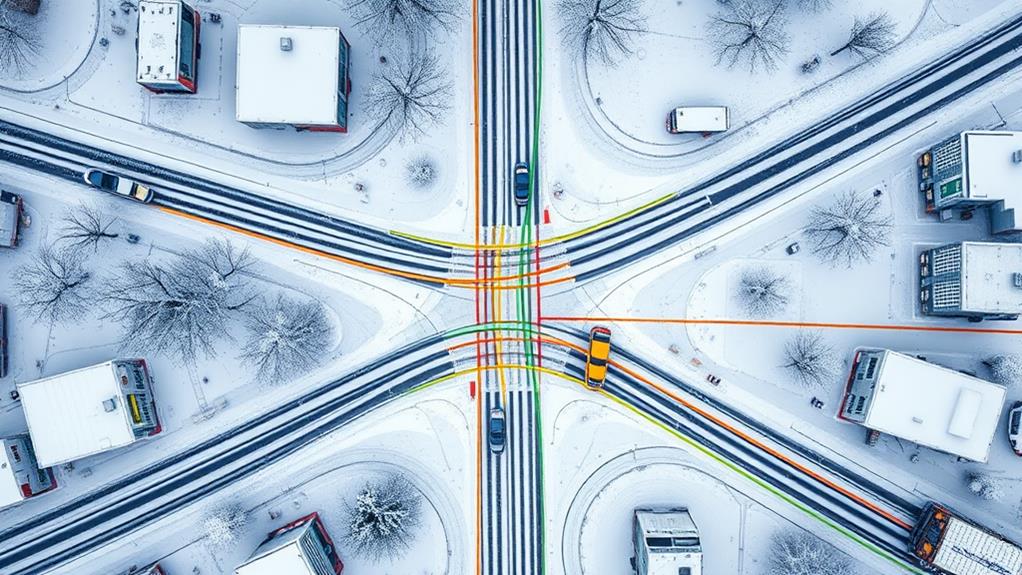
Snow Plow Solutions offers cutting-edge route optimization technology to revolutionize winter road maintenance strategies for municipalities, highway departments, and private contractors. By leveraging advanced algorithms and real-time data analysis, our software generates the most efficient snow plowing routes, reducing fuel consumption, labor costs, and response times.
This optimization guarantees that critical roads and high-traffic areas are cleared first, enhancing public safety and minimizing disruptions to daily life and commerce. MN Snow Solutions also provides expert snow plowing services and all-encompassing winter maintenance plans, certifying the highest standards in winter readiness.
Our system also integrates with weather forecasting services, allowing for proactive planning and resource allocation. By implementing Snow Plow Solutions' technology, clients can vastly improve their winter maintenance operations, leading to cleaner roads, happier residents, and substantial cost savings.
Route Planning and Mapping
Crafting an efficient winter road maintenance strategy begins with meticulous route planning and mapping. You'll need to analyze your area's road network, prioritizing main arteries, emergency routes, and high-traffic areas. By utilizing Geographic Information Systems (GIS) and specialized software, you can create detailed digital maps that incorporate pivotal data points such as road widths, slopes, and potential obstacles.
As you develop your snow plowing routes, consider factors like traffic patterns, population density, and critical infrastructure locations. You'll want to optimize these routes to minimize travel time and fuel consumption while maximizing the area covered. It's critical to divide your service area into manageable zones, assigning specific vehicles and crews to each sector. This approach assures comprehensive coverage and allows for more accurate time estimates for route completion.
Don't forget to account for variables such as vehicle turning radii, plow widths, and salt spreading patterns when planning your routes. By incorporating these details into your mapping process, you'll create a more efficient and effective snow removal strategy. Remember, well-planned routes lead to faster response times, improved road safety, and ultimately, a more satisfied community during challenging winter conditions.
Real-Time Weather Monitoring
As winter approaches, integrating real-time weather monitoring into your snow plowing strategy becomes essential. By incorporating advanced meteorological data and forecasting tools, you'll be better equipped to anticipate snowfall patterns, ice formation, and changing road conditions. This proactive approach allows you to deploy your snow removal resources more efficiently, ensuring that your community's roads remain safe and accessible throughout the winter season.
To implement an effective real-time weather monitoring system, you'll need to invest in reliable weather stations, radar systems, and road temperature sensors. These tools will provide you with up-to-the-minute data on precipitation, wind speeds, and surface temperatures, enabling you to make informed decisions about when and where to dispatch your plowing crews. Additionally, you should consider partnering with professional meteorological services to gain access to detailed forecasts and storm tracking information. By leveraging these resources, you'll be able to optimize your routes dynamically, adjusting your plowing strategy based on the most current weather conditions. This level of precision in your snow removal operations won't only improve safety for residents but also enhance your team's overall efficiency and cost-effectiveness.
Resource Allocation Strategies
Efficiency is the cornerstone of a successful winter road maintenance strategy, and resource allocation plays an essential role in achieving this goal. You'll need to carefully distribute your available assets, including personnel, equipment, and materials, to maximize their impact on snow removal operations. By strategically positioning plows, salt spreaders, and other specialized vehicles across your service area, you'll guarantee quick response times and full coverage during snowfall events.
To optimize your resource allocation, you should consider factors such as traffic patterns, road priorities, and historical weather data. You'll want to implement a tiered system that prioritizes main arterial roads, emergency routes, and critical infrastructure before addressing secondary and residential streets. This approach allows you to maintain crucial thoroughfares while systematically clearing less-traveled areas.
Additionally, you'll need to establish salt and sand depots at strategic locations throughout your jurisdiction, minimizing refill times and maximizing on-road efficiency. By leveraging GIS technology and real-time data analytics, you can dynamically adjust your resource allocation in response to changing weather conditions and emerging priorities, ensuring that your winter maintenance efforts remain agile and effective throughout the season.
Benefits

When you optimize your snow plowing routes, you'll reap numerous benefits that can drastically impact your winter maintenance operations. You'll experience substantial cost and resource savings, while also improving response times, which leads to enhanced safety measures for both your team and the public.
Additionally, optimized routes enable timely and thorough snow clearing, minimizing disruption during severe weather events. By streamlining your plowing routes, you'll reduce your environmental impact through decreased fuel consumption and more efficient use of de-icing materials, contributing to a more sustainable approach to snow removal.
Cost and Resource Savings
Numerous cost and resource savings can be achieved through optimized snow plowing routes. By implementing efficient routing strategies, you'll considerably reduce fuel consumption, vehicle wear and tear, and labor hours. These savings directly impact your bottom line, allowing you to allocate resources more effectively and potentially expand your service area.
Optimized routes also lead to improved equipment utilization. You'll be able to:
- Minimize idle time between plowing assignments
- Reduce unnecessary backtracking and overlapping routes
- Maximize the use of each vehicle's capacity and capabilities
Furthermore, by streamlining your operations, you'll decrease overtime costs and enhance overall productivity. Efficient routing enables your crews to complete their tasks more rapidly, reducing the need for extended shifts during severe weather events. This not only saves on labor expenses but also helps maintain employee morale and safety.
Additionally, optimized routes can lead to reduced salt and de-icing material usage. By precisely targeting high-priority areas and avoiding overtreatment, you'll conserve valuable resources and minimize environmental impact. These cost-effective practices demonstrate your commitment to sustainable snow management, potentially attracting environmentally conscious clients and improving your competitive edge in the industry.
Improved Response Times
Through optimized snow plowing routes, you'll dramatically enhance your response times during winter weather events. By strategically planning your routes, you can make certain that significant areas are cleared first, minimizing disruptions to traffic flow and emergency services. This improved efficiency allows you to cover more ground in less time, reducing the overall impact of snowfall on your community.
With optimized routes, you'll be able to prioritize high-traffic areas, main thoroughfares, and emergency routes, ensuring that these essential pathways are cleared quickly and effectively. This systematic approach enables you to allocate your resources more efficiently, deploying plows and salt spreaders where they're needed most. As a result, you'll see a significant reduction in the time it takes to make roads safe and passable after a snowstorm.
Additionally, by incorporating real-time data and weather forecasts into your route planning, you can proactively adjust your response to changing conditions, further improving your ability to keep roads clear and safe. This level of responsiveness not only enhances public safety but also demonstrates your commitment to providing exceptional snow removal services to your community.
Enhanced Safety Measures
Enhanced safety measures are a key benefit of snow plowing route optimization. By implementing advanced routing algorithms, you'll drastically reduce the risk of accidents and improve overall road safety during winter conditions. These optimized routes guarantee that critical areas, such as intersections, school zones, and high-traffic corridors, are prioritized and cleared more efficiently. This strategic approach minimizes the time roads remain hazardous, thereby decreasing the likelihood of weather-related incidents.
When you adopt snow plowing route optimization, you'll experience:
- Reduced black ice formation on frequently traveled roads
- Improved visibility at intersections through strategic snow bank management
- Faster clearance of emergency routes for first responders
Furthermore, optimized routes allow for more consistent application of de-icing materials, preventing over-salting in some areas and under-treatment in others. This balanced approach not only enhances safety but also minimizes environmental impact. By utilizing real-time weather data and traffic patterns, route optimization enables your snow removal teams to adapt quickly to changing conditions, ensuring that they're always addressing the most critical areas first. This proactive stance on winter maintenance greatly contributes to safer roadways for all community members, reducing the risk of accidents and improving overall mobility during harsh weather events.
Environmental Impact Reduction
Optimizing snow plowing routes offers three key environmental benefits that can markedly reduce your community's ecological footprint. First, you'll see a significant decrease in fuel consumption and emissions, as vehicles travel more efficiently along carefully planned paths. This reduction in greenhouse gases contributes to improved air quality and helps combat climate change, aligning your community with global environmental goals.
Secondly, optimized routes minimize the use of de-icing agents and road salt, which can harm local ecosystems when overused. By strategically applying these materials only where necessary, you'll protect vegetation, aquatic life, and groundwater from excessive chemical exposure. This targeted approach maintains road safety while safeguarding the natural environment.
Lastly, efficient snow removal reduces the wear and tear on roads and infrastructure. By minimizing the time snow and ice remain on surfaces, you'll extend the lifespan of roadways, reducing the need for frequent repairs and repaving. This conservation of resources translates to less material consumption and fewer construction-related emissions over time. Ultimately, route optimization creates a more sustainable snow management system that benefits both your community and the environment.
Snow Plowing Company Near you

Snow Plow Solutions offers thorough commercial snow plowing and removal services to guarantee your business remains operational during winter weather events. Our skilled team utilizes state-of-the-art equipment and route optimization technology to efficiently clear parking lots, driveways, and walkways, minimizing downtime and potential liability risks.
We pride ourselves on our reliable and efficient snow removal services for businesses, ensuring safe and accessible spaces for your staff and customers. By partnering with Snow Plow Solutions, you can focus on running your business while we handle the challenging task of snow and ice management, providing peace of mind and maintaining safe access for your employees and customers throughout the winter season.
Connect With A Team Member Today!
Don't let winter weather slow you down! Optimize your snow plowing routes for maximum efficiency and customer satisfaction.
Our expert team is ready to help you streamline your operations and boost your bottom line. Take the first step towards a more profitable winter season – call us now at (555) 123-4567 to schedule a free consultation.
Commercial snow plowing guarantees that large parking lots, retail spaces, and office buildings are kept clear of snow and ice. Let's clear the way to success together!
Environmental Impact of Salt Usage
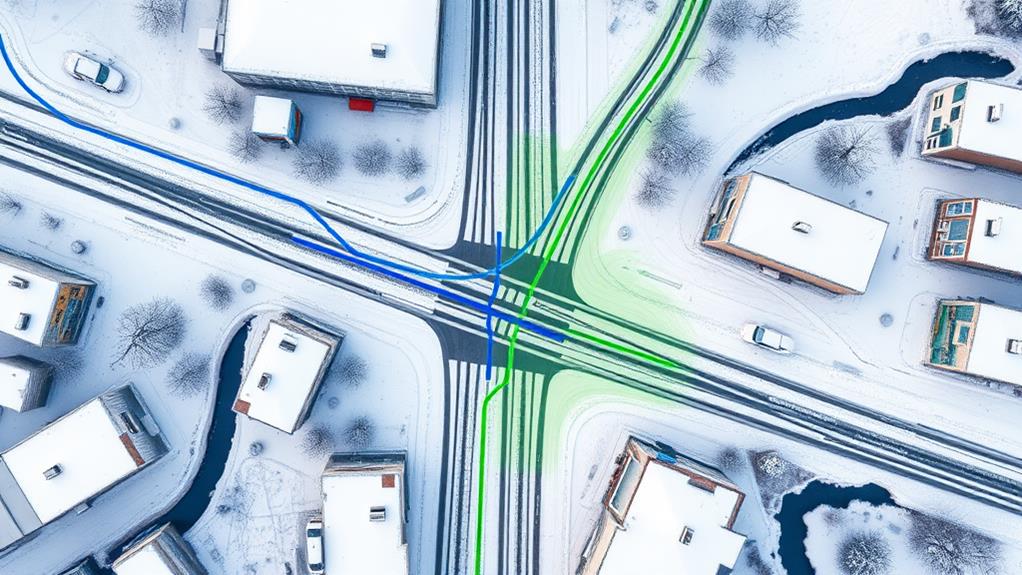
As you consider the environmental impact of salt usage in snow removal, you'll find that it's a complex issue with far-reaching consequences. Salt's effects on vegetation, waterway contamination, and the exploration of alternative de-icing methods are all significant aspects to examine when evaluating your snow plowing strategy. To help you understand these factors more clearly, consider the following table, which outlines key points related to salt's environmental impact and potential alternatives:
| Environmental Concern | Impact of Salt | Alternative Solutions |
|---|---|---|
| Vegetation Damage | Soil salinity increase, plant stress | Organic de-icers, sand/gravel mixtures |
| Waterway Contamination | Chloride buildup, aquatic life harm | Brine solutions, reduced application rates |
| Infrastructure Corrosion | Road/bridge deterioration, vehicle damage | Corrosion inhibitors, heated pavement systems |
| Soil Structure | Soil compaction, reduced fertility | Mechanical removal, permeable pavements |
Salt's Effect on Vegetation
The widespread use of road salt during winter maintenance operations has significant environmental consequences, particularly on vegetation. As you plan your snow plowing routes, it's imperative to contemplate how salt affects the plants in your community.
Salt exposure can lead to dehydration, nutrient deficiencies, and reduced growth in vegetation along roadways and in nearby ecosystems. When salt-laden snow melts, it seeps into the soil, altering its chemistry and potentially harming root systems.
To visualize the impact of salt on vegetation, consider these effects:
- Browning and wilting of leaves on trees and shrubs
- Stunted growth and reduced flowering in roadside plants
- Bare patches in grass and other ground cover near salted areas
Waterway Contamination Issues
Salt's impact on vegetation is just one piece of the environmental puzzle. When you consider the broader effects of snow removal practices, you'll find that waterway contamination is a significant concern.
As you're aware, the salt and other de-icing chemicals used on roads don't simply disappear after the snow melts. They're washed into storm drains, streams, and rivers, potentially altering the chemical composition of these water bodies.
This runoff can have far-reaching consequences for aquatic ecosystems. You'll notice that elevated chloride levels can be toxic to fish, amphibians, and other aquatic organisms, disrupting their natural habitats. Additionally, the contamination can affect the quality of drinking water sources, posing potential health risks to your community.
As responsible members of your neighborhood, it's indispensable to understand that the choices made in snow removal strategies have ripple effects throughout the local environment. By optimizing plowing routes and using salt judiciously, you're not only ensuring safe winter travel but also protecting the water resources that are essential to your community's well-being and the health of local ecosystems.
Alternative De-Icing Methods
Environmentally conscious communities are increasingly seeking alternatives to traditional salt-based de-icing methods. As you consider optimizing your snow plowing routes, it's essential to explore these eco-friendly options that can reduce the negative impact on local ecosystems and infrastructure. Some effective alternatives include:
- Beet juice mixtures, which lower the freezing point of water and adhere well to road surfaces
- Sand or gravel applications, providing traction without chemical runoff
- Heated pavement systems, utilizing geothermal or electric energy to prevent ice formation
These methods can be integrated into your existing snow removal strategy, offering a balance between efficiency and environmental stewardship. By adopting alternative de-icing techniques, you'll join a growing network of communities prioritizing sustainability in winter maintenance. It merits observation that while these methods may have higher initial costs, they often result in long-term savings through reduced corrosion damage to vehicles and infrastructure. Additionally, you'll minimize the harmful effects on vegetation, aquatic life, and groundwater quality.
As you refine your snow plowing routes, consider implementing these alternatives strategically, focusing on areas most vulnerable to environmental impact or where traditional salt usage has proven problematic.
Frequently Asked Questions
How Does Weather Forecasting Affect Snow Plowing Route Optimization?
You'll find weather forecasting vital for your route planning. It helps you anticipate snow accumulation, timing, and intensity. You can adjust your routes, prioritize areas, and allocate resources efficiently, ensuring you're always one step ahead of the storm.
What Technology Is Used to Track and Manage Snow Plowing Fleets?
You'll find GPS tracking, telematics, and fleet management software are key to monitoring your plowing fleet. These tools let you track locations, optimize routes, and communicate with drivers in real-time, keeping everyone connected and efficient.
How Are Priority Routes Determined for Snow Plowing Operations?
You'll find that priority routes are determined by considering traffic volume, emergency services access, and public safety. You're part of the community, so main roads, school zones, and hospital routes are typically cleared first to keep everyone connected.
What Training Do Snow Plow Operators Receive for Route Optimization?
You'll receive training on GPS navigation, real-time weather updates, and efficient route planning. You'll learn to prioritize critical areas and adapt to changing conditions. Together with your team, you'll keep your community safe and connected during winter storms.
How Do Cities Coordinate Snow Plowing Efforts With Neighboring Municipalities?
You'll find cities often work together, sharing resources and information. They'll coordinate routes, establish mutual aid agreements, and communicate frequently during storms. You're part of a larger community effort to keep everyone safe and mobile.
